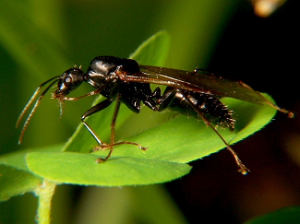Are the Swarmers Ants or Termites?
By Chris Williams on July 14, 2015.

Carpenter Ant Winged Male
My husband found hundreds of swarming, winged insects around the outside of our house and crawling up the siding. It looked like they were coming out of the ground around the foundation. He said they looked like ants but I’m worried they might be termites. F. J., Pepperell, MA
Without seeing specimens, I couldn’t tell for sure whether you have reproductive swarming ants or swarming termites. Collect and save some of the insects in a jar, then give Colonial Pest a call. Our technicians can identify the insects for you and can perform an inspection to see where the swarmers are coming from.
The Differences Between Winged Ants and Winged Termites
A trained eye can definitely distinguish between a winged ant and a winged termite (see How to Identify Swarming Termites). There are characteristics that you can see, even without magnification:
(1) Termites have two pairs of wings of equal size; ants have a larger front pair of wings and a smaller secondary pair.
(2) Termites’ antennae are straight; ants’ antennae are elbowed or bent in the middle.
(3) Termites have a thick “waist,” there is no noticeable narrowing between the thorax and the abdomen; ants have what we call a “wasp waist,” with a noticeable thin pedicel segment connecting the thorax and abdomen.
There’s a Reason Why Swarmers Swarm
Like termites, ants swarm to start new colonies (see Why Do Termites Swarm?). When the colony is of a certain size and age (at least two years old) or is under stress, winged reproductive ants are produced. These kings and queens are larger than the worker ants in the colony. They fly off and mate (or sometimes mate first within the colony), the male dies shortly after, and the female sheds her wings and looks for a ground nest site where she will lay eggs.
Depending on the species of ant, swarms can occur anytime from early spring to early fall with most swarms occurring in late spring. Subterranean termites usually swarm in early spring but there is a lot of regional variability. As with termites, ant swarms are usually triggered by weather conditions. Warm, wet weather can send ant or termite swarmers out on their nuptial flights.
Whether the swarmers are ants or termites, seeing them outside around the foundation does not necessarily mean that they are infesting your home. It’s more likely that they are not (see Outdoor Termite Swarms Don’t Mean an Indoor Infestation). On the other hand, seeing many ant or termite swarmers inside your house usually means that the infestation is indoors. This is why a professional inspection is important. Give Colonial Pest a call today!
Photo Credit: By Bruce Marlin [CC BY-SA 2.5], via Wikimedia Commons